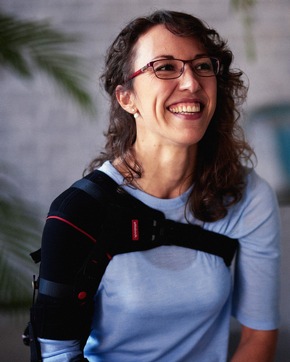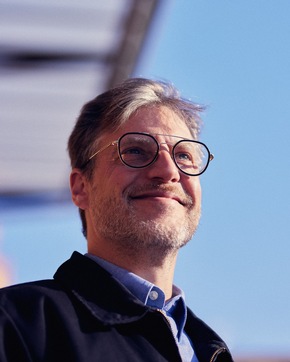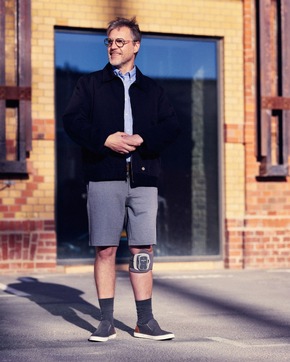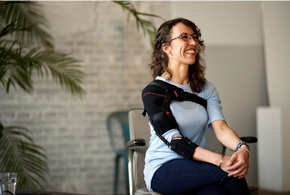World Stroke Day: Donation campaign
“That single second changed my life!”
Stroke survivors share how they got their lives back – Ottobock makes a donation for every rehabilitation story
Every year, thirteen million people around the world have a stroke1. In the US, someone has a stroke every forty seconds2: The blood flow to the brain is blocked and therefore the supply of oxygen as well. In other cases, bleeding occurs in the skull. Survivors often struggle with hemiplegia, or paralysis on one side of the body. High-tech solutions can help. People affected by stroke are sharing their stories for World Stroke Day on 29 October 2021. To give other stroke survivors courage, the HealthTech company Ottobock is donating to the World Stroke Organization for every shared Instagram story about life after stroke (details below*).
Maja has feeling in her foot again
Take Maja Havbring’s case, for example. Maja, a native of Sweden, had a stroke when she was 44 years old. She was paralyzed on one side of her body and had to learn how to walk and talk again: “I had a great deal of trouble walking, making decisions, and remembering simple everyday tasks. My body was like a different body, one I didn’t know,” she says. Thanks to years of training, she has her mobility back. The Exopulse Mollii Suit, a suit equipped with electrodes for neuromodulation, helped her reduce the spasticity in her left arm and leg. “I had feeling in my foot again for the first time in a long time,” she says. “It was like it was dead – now I feel connected to my body again. This helped me get my life back. Nothing seems impossible anymore!”
Dirk can go hiking again
Dirk Mertens, a native of Cologne, Germany, also had a stroke: “That single second changed my life. I was lying completely motionless in bed and couldn’t even move at all at first,” he recalls. “It turned our whole life as a family upside down.” At first, Dirk used a wheelchair and relearned how to get up the stairs to his flat on the third floor. “From that point on I started to fight my way back into life,” he says. Now, Dirk can even go hiking again.“I’m a tech freak, so that’s why I opted for an electrostimulation solution,” he notes. He wears a neuro-orthosis on his leg ( L300 Go) that lifts his foot. Electrical impulses stimulate the nerves that the central nervous system no longer has control over after the stroke.
Video: Dirk's Social Media Statement
Marleen can drive again
Marleen Zander, who lives near Göttingen, Germany, was just 20 years old when a stroke changed her life. She had been studying mathematics, was a hip-hop dancer, and had a large circle of friends. She was in a coma for two weeks after having a stroke: “I woke up and was paralyzed on my right side,” Marleen says. Her old life was gone; she couldn’t speak or solve math problems anymore. Today she works at a healthcare center, has built up a new circle of friends, and can drive and walk normally again without attracting unwanted stares. “I don’t have to use a cane or wear giant shoes anymore,” she says. “I’m incredibly thankful to be independent again!” A neurostimulation system uses electricity to stimulate the paralyzed muscles in Marleen’s leg; an orthosis ( Omo Neurexa plus) also helped her hold her arm in the proper position, which promotes a natural gait pattern.
Video: Marleen's Social Media Statement
*Info: Ottobock is donating five euros to the World Stroke Organization for every photo and video about rehabilitation after a stroke posted on Instagram between 25 October and 2 November. In order for the donations to be made to the World Stroke Organization, the hashtags #StrokeLifeFundraiser and #Ottobock must be used correctly and the @Ottobockchannel must be mentioned.
If you would like to interview Marleen, Dirk, or one of the developers behind the medical devices for stroke patients, please do get in touch with our media contact.
About Ottobock
For more than 100 years, Ottobock has developed innovative products. Meanwhile, the med-tech company also takes care of the full treatment cycle for people with disabilities all over the globe. Initially, the company revolutionized the market thanks to the series production of prosthetic components. Since then, the focus has turned to products designed to help improve mobility after a stroke, microprocessor-controlled knee joints, the computer-controlled C-Brace leg orthosis, the multi-articulating bebionic hand, wheelchairs, and bionic exoskeletons.
Sources
1 World Stroke Organization
2 CDC (Centers for Disease Control and Prevention)
Maja Hoock
Public Relations Managerin
Handy: +49 151 18883507
E-Mail: maja.hoock@ottobock.de
.jpg)
.jpg)
%201.jpg)



